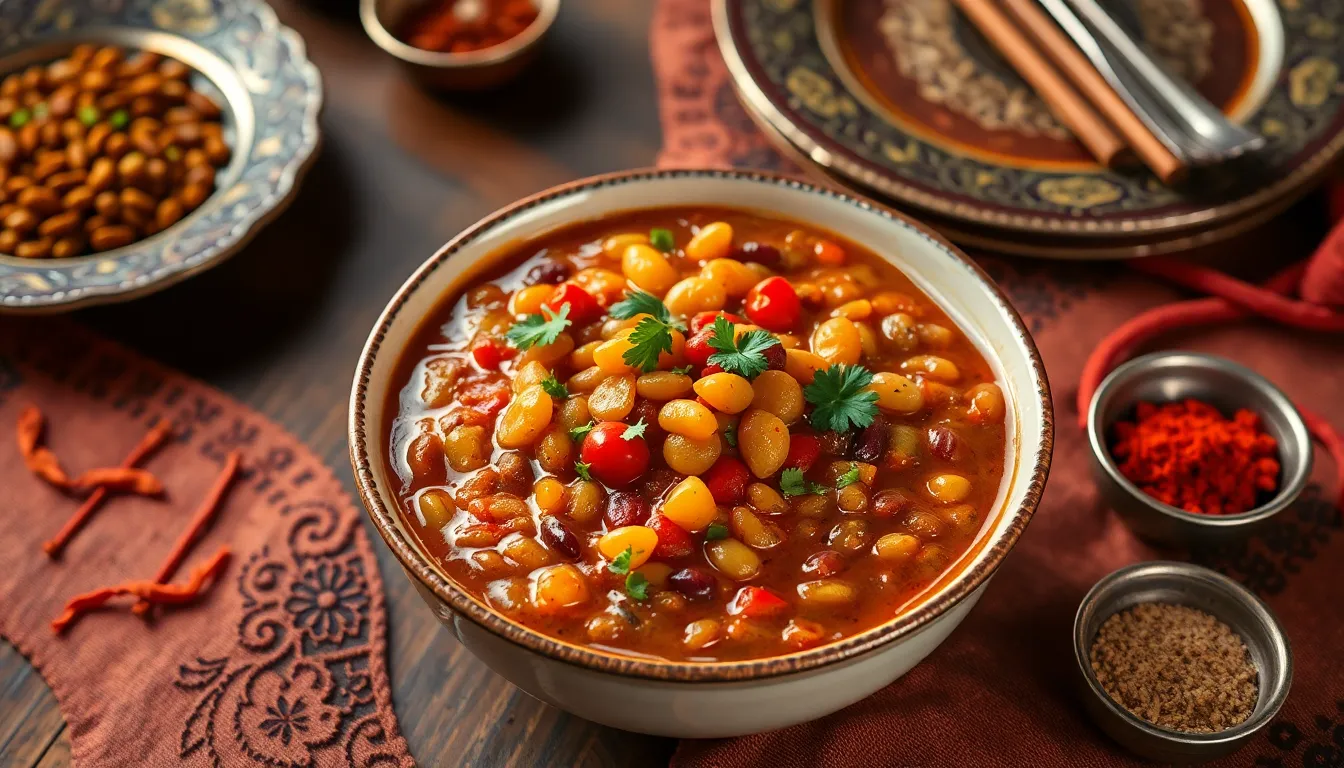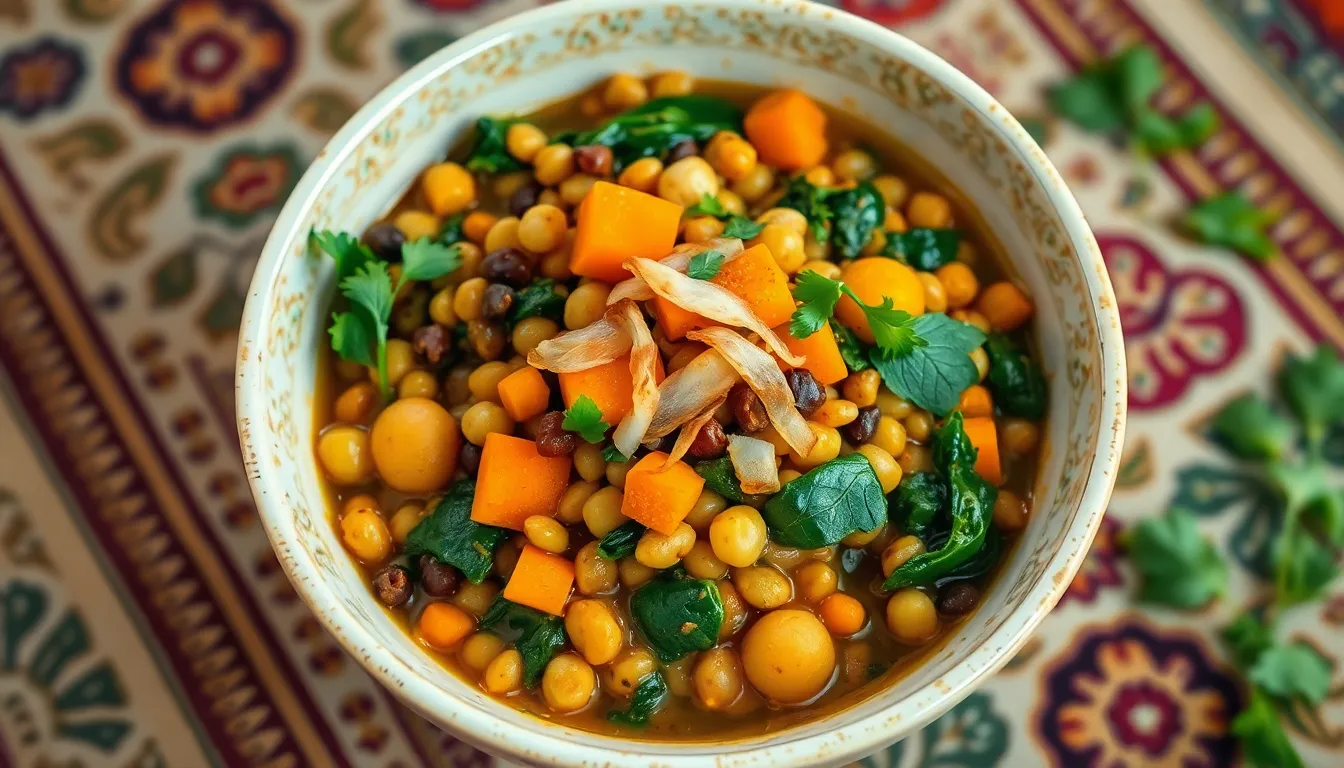In the vibrant world of Indian cuisine, few dishes spark curiosity quite like rasnkada. This lesser-known gem combines rich flavors with an intriguing history that’s sure to tickle anyone’s taste buds. Imagine a dish that’s not just food but a delightful experience, blending spices and textures in a way that leaves you craving more.
Table of Contents
ToggleOverview of Rasnkada
Rasnkada stands out in Indian cuisine for its enchanting flavors and cultural significance. This dish originates from a blend of regional influences, showcasing various spices that enhance its appeal. A mix of lentils, vegetables, and spices forms its foundation, offering a nutritious profile.
Rasnkada typically features ingredients like turmeric, cumin, and coriander, which contribute to its vibrant taste. The preparation involves slow cooking, allowing flavors to meld perfectly. Many traditional recipes vary by region, reflecting local preferences and available ingredients.
Savoring rasnkada provides a unique culinary experience. Diners often appreciate not just the taste but also the visual presentation of the dish. This engaging aspect makes it a popular choice for meals and celebrations in different communities.
Variations of rasnkada exist, catering to diverse palates. For instance, some may include coconut for creaminess, while others focus on a spicier kick. Each version offers distinct flavors while maintaining the essence of the original dish.
Rasnkada’s popularity has transcended borders. Many international restaurants now feature it on their menus, captivating non-Indian diners. As a result, this dish continues to evolve while preserving its rich history, making it a beloved meal for many.
History of Rasnkada

Rasnkada’s history reflects a rich tapestry of culinary traditions in Indian cuisine. This dish emerged from a blend of regional influences, showcasing various ingredients and techniques.
Origin
Rasnkada traces its roots to ancient Indian cooking practices that emphasized the importance of spices. Regional communities contributed unique interpretations, making it a versatile dish. Traditionally, lentils served as the foundation, harmonizing with vegetables and spices like turmeric, cumin, and coriander. The slow cooking method allowed flavors to deepen, enhancing the overall experience. Variations arose over time, each reflecting the local palate, ensuring rasnkada’s continued relevance.
Cultural Significance
Rasnkada holds a special place in Indian culture, often featured in festive and celebratory meals. This dish symbolizes hospitality, with families preparing it for gatherings and special occasions. Its vibrant colors and aromatic spices not only please the palate but also enhance the visual appeal of the meal. In many regions, it represents a connection to heritage and tradition, as families pass down recipes through generations. The rise of rasnkada on international menus indicates its growing acknowledgment beyond Indian borders, further embedding it into the global culinary landscape.
Benefits of Rasnkada
Rasnkada offers numerous advantages that enhance its appeal beyond taste. This dish not only delights the palate but also contributes to overall well-being.
Nutritional Value
Rasnkada showcases an impressive nutritional profile. High protein content comes from lentils, providing essential amino acids. Fiber-rich vegetables contribute to digestive health, while spices like turmeric and cumin offer antioxidants. Vitamins from ingredients such as spinach or carrots enhance nutrient density. Also, rasnkada contains healthy fats, particularly when coconut is included. Overall, this dish serves as a wholesome choice, satisfying hunger while nourishing the body.
Health Benefits
Health benefits associated with rasnkada make it a valuable meal option. Antioxidants present in spices support immune function and reduce inflammation. Incorporating fiber aids in digestion and maintains stable blood sugar levels. The inclusion of lentils can boost heart health by managing cholesterol levels. Nutrients found in vegetables promote skin health and improve energy levels. Each element of rasnkada combines to create a dish that fosters both physical health and satisfaction.
How to Prepare Rasnkada
Preparing rasnkada involves simple yet essential steps that bring out its rich flavors. Understanding the ingredients and cooking method ensures a delightful dish every time.
Ingredients
Key components include lentils, which serve as the base for rasnkada. Fresh vegetables, such as spinach and carrots, add nutrition and color. Spices like turmeric, cumin, and coriander infuse the dish with warmth and depth. It’s common to see onions and garlic for an aromatic foundation. Coconut milk can provide creaminess, while green chilies add a spicy kick. Salt enhances flavors, adjusting to personal preference. Gathering these ingredients sets the stage for a memorable culinary experience.
Cooking Method
Begin with rinsing and soaking lentils for better texture. Heating oil in a pan warms the spices and releases their aromas. Next, adding onions and garlic creates a fragrant base. Stir in chopped vegetables once the onions soften, allowing them to cook briefly. Incorporating soaked lentils with water brings everything together, ensuring an even cook. Simmering the mixture for at least 30 minutes enables flavors to meld perfectly. Lastly, adjusting seasoning enhances the dish’s profile before serving warm.
Popular Variations of Rasnkada
Rasnkada showcases numerous popular variations that reflect regional influences and ingredient availability. One well-known version includes coconut, which adds creaminess and a subtle sweetness, enriching the overall flavor profile. Another delightful variation features additional spices, providing a spicier kick that appeals to those who enjoy bold tastes.
In certain regions, they incorporate seasonal vegetables, such as eggplant and kale, enhancing nutrition and flavor diversity. Some adaptations utilize different lentil types, like red or split yellow lentils, each contributing unique textures and tastes. The addition of tamarind creates a tangy twist, elevating the dish’s complexity while pairing harmoniously with the spices.
Individual communities often share their special recipes, representing family traditions and regional pride. Celebrations often call for variations that include rich toppings, such as fried onions or fresh herbs, adding visual appeal and layers of taste. Occasionally, chefs experiment with fusion versions, incorporating global ingredients alongside traditional ones, expanding rasnkada’s charm beyond its origins.
Nutritional variations emerge as well, with some recipes reducing oil for a healthier option while maintaining flavor integrity. Cultural context deeply influences how these variations form, ensuring rasnkada evolves while preserving its essence. Each spin on rasnkada invites diners on a flavorful journey through Indian culinary heritage, reflecting local ingredients and innovative cooking techniques.
Rasnkada is a culinary gem that embodies the rich tapestry of Indian cuisine. Its unique blend of flavors and textures offers a memorable dining experience that goes beyond mere sustenance. As it continues to gain popularity both locally and internationally, rasnkada serves as a delicious reminder of the cultural significance and versatility of traditional Indian dishes.
Whether enjoyed during festive occasions or as a comforting meal at home, rasnkada stands out as a nourishing choice that delights the senses. The dish not only satisfies hunger but also connects people to their heritage through its time-honored recipes and regional variations. Embracing rasnkada is an invitation to explore the vibrant world of Indian flavors and the stories they tell.



